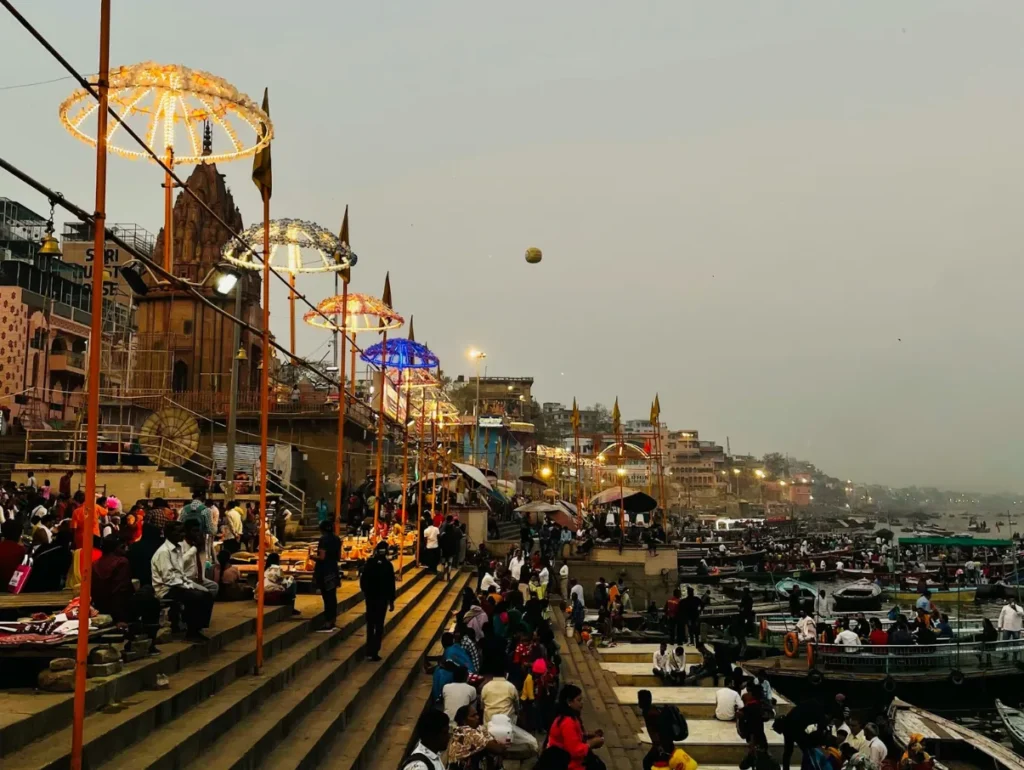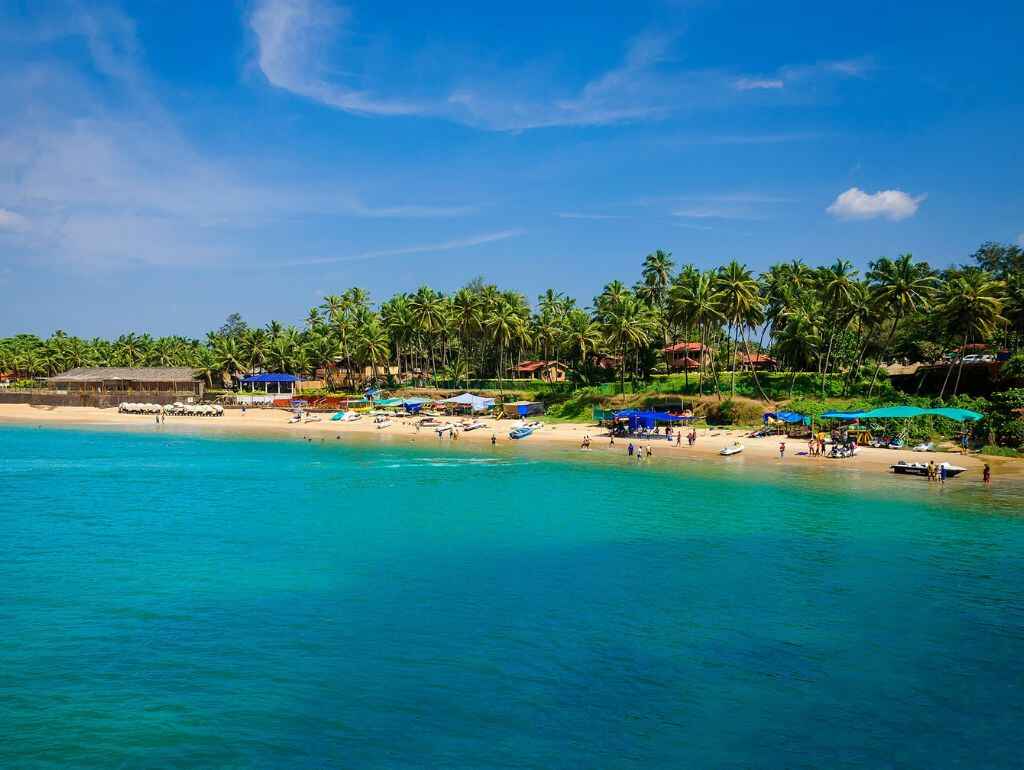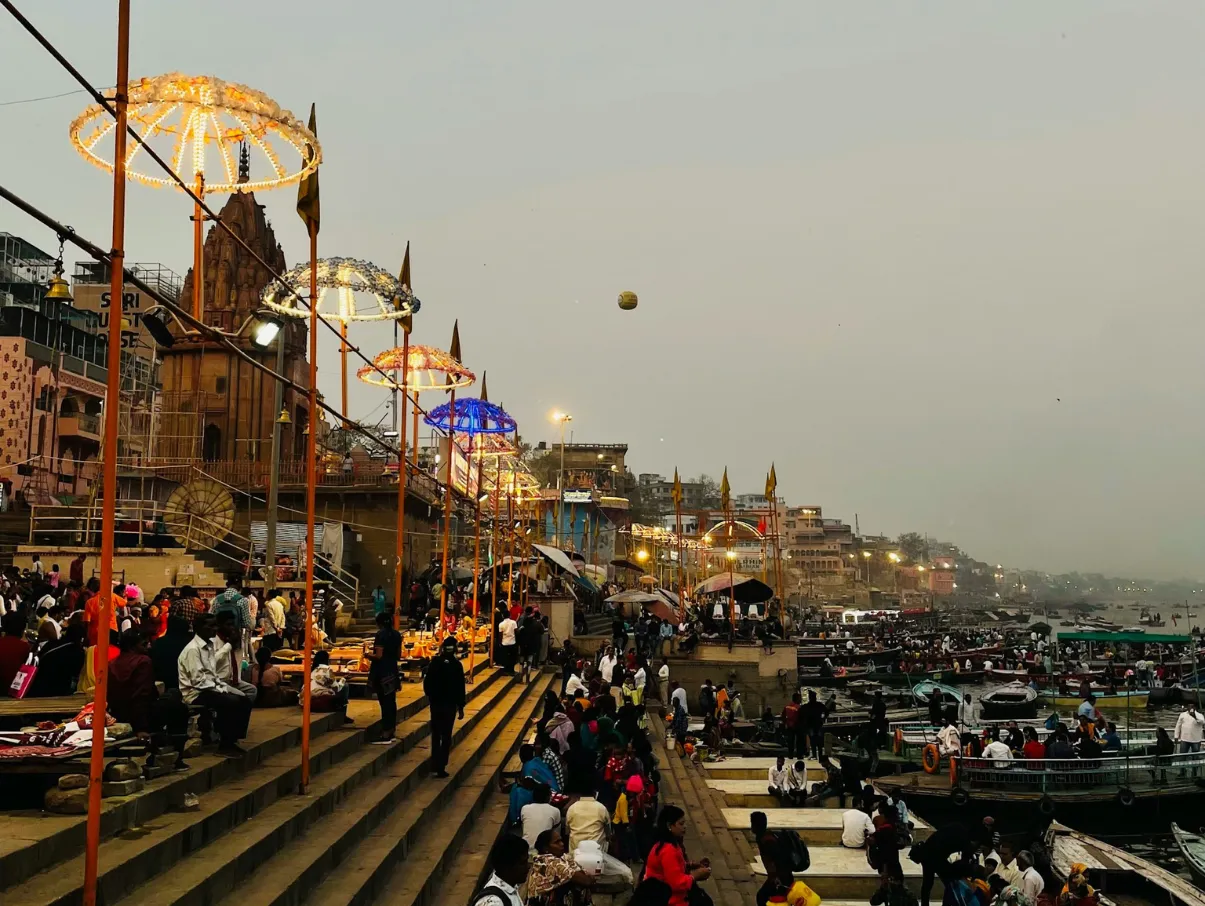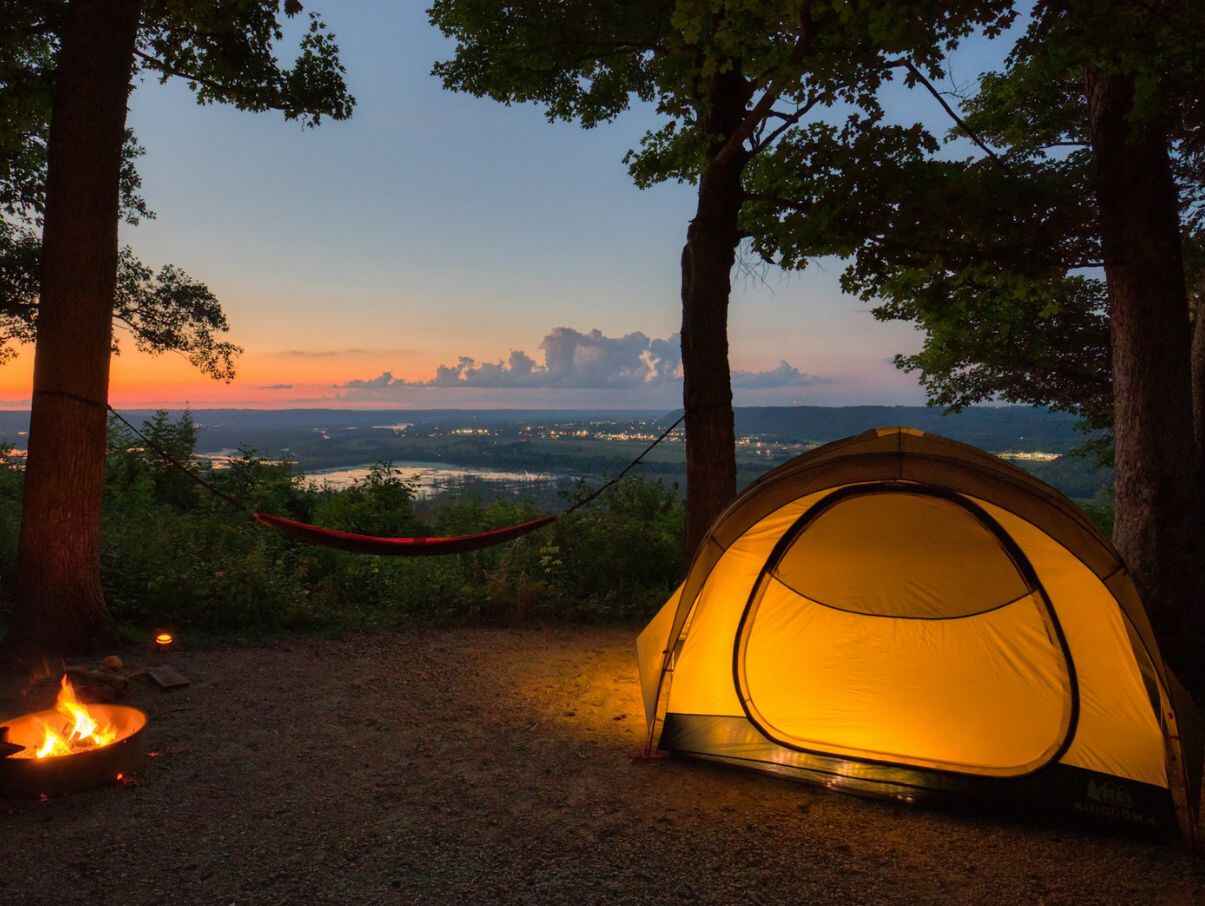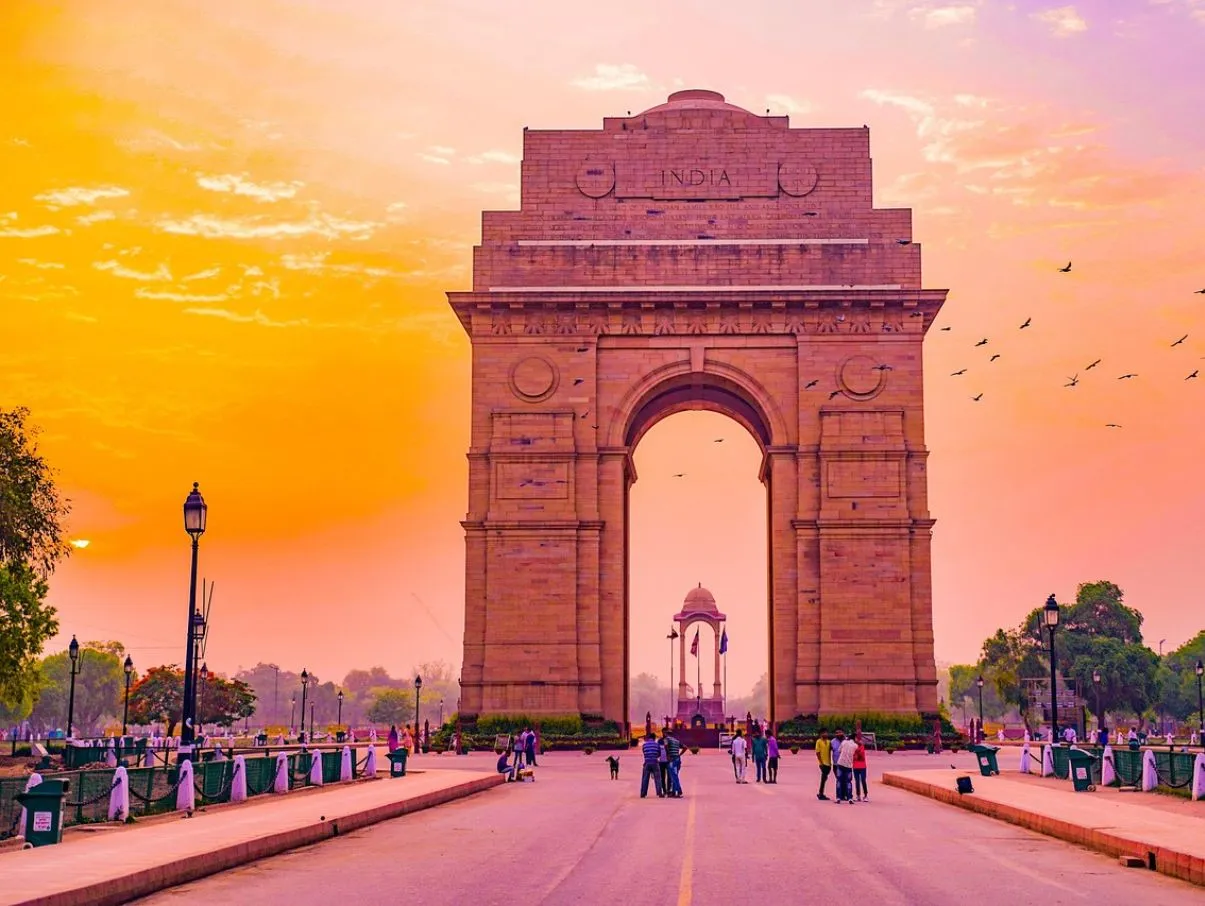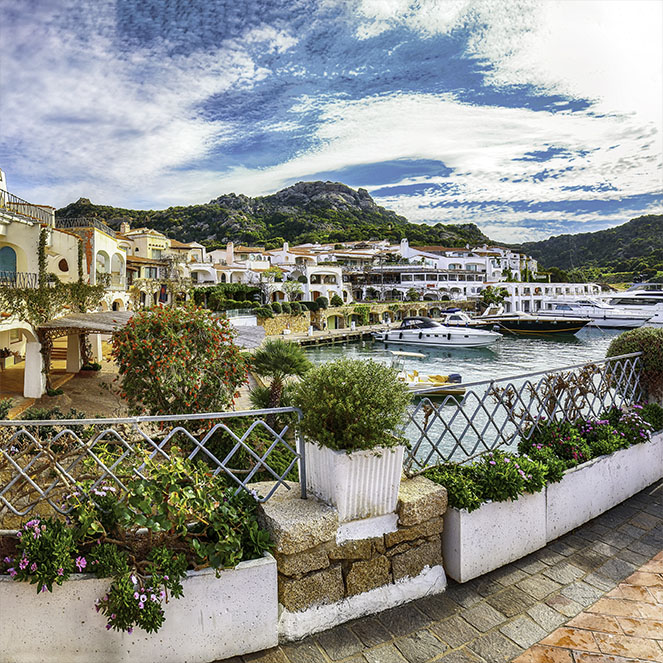Why Banaras Calls Your Name
- Spiritual Awakening: The sacred River Ganga, the countless temples, and the daily rituals offer a profound spiritual experience.
- Historical Depth: Every alley, every building seems to whisper tales of centuries gone by.
- Vibrant Culture: From the bustling markets to the serene mornings on the ghats, it’s a sensory feast.
- Unique Ghats: Each ghat has its own story, its own purpose, collectively forming the city’s iconic riverside panorama.
Ideal Duration for Your Banaras Trip
- 2-3 Days: Sufficient for covering the major highlights and soaking in the atmosphere.
- 4-5 Days: Allows for a deeper exploration, including day trips to nearby Sarnath, more time for contemplation, and less rushed experiences.
Top Tourist Attractions in Varanasi
1. The Ghats of Varanasi:
- Dashashwamedh Ghat: The most famous and vibrant ghat, it’s the epicenter of activity. Every evening, the spectacular Ganga Aarti takes place here, a mesmerizing ritual of fire, incense, music, and chanting performed by a group of priests. Witnessing this ceremony is a highlight of any Varanasi visit. Early mornings also see pilgrims taking holy dips, performing pujas, and offering prayers.
- Manikarnika Ghat: This is one of the two main cremation ghats in Varanasi. It’s a powerful and intense site where the cycle of life and death is openly observed. Hindu belief holds that those cremated here attain moksha (liberation from the cycle of rebirth). While profoundly spiritual, it requires respect and sensitivity from visitors.
- Assi Ghat: Located at the southern end, it’s known for its serene atmosphere and is popular with locals and students. It also hosts its own smaller, more intimate morning Aarti and is a great spot for sunrise views and relaxing.
- Harishchandra Ghat: The second cremation ghat, similar in significance to Manikarnika but often less crowded.
- Boat Rides on the Ganga: A must-do experience. Hiring a boat (especially at sunrise or sunset) allows you to witness the ghats from the river’s perspective, observing the rituals, the Ganga Aarti, and the daily life unfolding along the banks. It offers a panoramic view of the ancient city’s silhouette.
2. Kashi Vishwanath Temple:
3. Sankat Mochan Hanuman Temple:
4. Durga Temple (Durga Kund):
5. Annapurna Devi Temple:
6. Nepali Temple (Pashupatinath Temple Replica):
7. Narrow Lanes (Galies) and Markets:
The true essence of Varanasi lies in its labyrinthine narrow lanes. Wandering through these bustling alleyways is an adventure in itself, revealing hidden temples, vibrant markets selling silk sarees, local handicrafts, religious paraphernalia, and an array of street food. It’s a sensory overload of sights, sounds, and smells.
8. Banaras Hindu University (BHU) & Bharat Kala Bhavan
9. Varanasi Silk Weaving:
10. Street Food Tour
Top Tourist Attractions in Sarnath: Where Buddhism Took Root
1. Dhamek Stupa: This massive and prominent stupa marks the exact spot where Buddha gave his first sermon. Standing at 43.6 meters high and 28 meters in diameter, it’s largely built of brick and stone, adorned with intricate carvings. It’s the most striking monument in Sarnath.
2. Chaukhandi Stupa: Before reaching the Dhamek Stupa, you’ll encounter the Chaukhandi Stupa. This structure is believed to be the place where Buddha met his first five disciples as they were traveling from Bodh Gaya. A picturesque octagonal tower built by Emperor Akbar in the 16th century stands atop its often-repaired brick base.
3. Sarnath Archaeological Museum: This is an absolute must-visit. It houses an exceptional collection of artifacts from the Maurya, Kushana, and Gupta periods. Its most prized possession is the magnificent Ashoka Lion Capital, the national emblem of India, originally topping the Ashoka Pillar. You’ll also find a large collection of Buddhist sculptures, figurines, and other relics excavated from the site.
4. Ashoka Pillar Ruins: The original Ashoka Pillar, erected by Emperor Ashoka in the 3rd century BCE to mark the spot of Buddha’s first sermon, stands in ruins near the Dhamek Stupa. While the famous Lion Capital is in the museum, the base of the pillar remains at its original location, providing a sense of historical grandeur.
5. Mulgandh Kuti Vihar: A modern Buddhist temple built by the Maha Bodhi Society, it houses beautiful frescoes depicting the life of Buddha by a Japanese artist, Kosetsu Nosu. A sacred Bodhi tree, grown from a cutting of the original tree in Anuradhapura, Sri Lanka (which itself came from the original Bodhi tree in Bodh Gaya), stands adjacent to the temple.
6. Deer Park (Isipatana): This serene and peaceful park is where Buddha delivered his first sermon. It’s a tranquil place for reflection, evoking the historical significance of the site where the wheel of Dharma was first set in motion.
7. Monastery and Temple Ruins: Scattered throughout Sarnath are the remains of ancient monasteries, temples, and learning centers, offering glimpses into the once-flourishing monastic community that existed here for centuries.
8. International Buddhist Temples: Sarnath is home to several temples and monasteries built by various Buddhist countries, including Thai, Tibetan, Japanese, and Chinese temples, each showcasing their unique architectural styles and reflecting the global impact of Buddha’s teachings.
Getting To Banaras
• By Air: Lal Bahadur Shastri International Airport (VNS) connects Varanasi to major Indian cities like Delhi, Mumbai, Kolkata, Bengaluru, Chennai, and Hyderabad.
• By Train: Varanasi Junction (BSB) is a major railway station with excellent connectivity across India. Manduadih Railway Station (MV) is another important station, often less crowded.
• By Road: Good bus services and private taxis connect Varanasi to nearby cities and towns.
Accommodation Options in Banaras
Varanasi offers a wide range of stays to suit every budget and preference.
• Budget (₹500 – ₹2000 per night): Numerous guesthouses and hostels, especially concentrated near the main ghats (Dashashwamedh, Assi) and in the old city. Perfect for backpackers and those seeking an authentic, no-frills experience.
• Mid-Range (₹2000 – ₹5000 per night): Boutique hotels, comfortable guesthouses with modern amenities, and resorts often found slightly away from the immediate ghat area, offering a balance of comfort and reasonable pricing.
• Luxury (₹5000+ per night): High-end hotels and heritage properties, often with excellent views, premium services, and located in quieter areas like the Cantonment or overlooking the Ganga.
Essential Banarasi Delights (Food)
- Banarasi Lassi: Thick, creamy, and often topped with rabri and dry fruits.
- Chaat: Aloo Tikki, Tamatar Chaat, Golgappe – Varanasi does it best.
- Kachori Sabzi: A staple breakfast of crispy fried bread with spicy potato curry.
- Malaiyo (Winter Special): A frothy, airy dessert made from milk cream.
- Thandai: A refreshing, chilled milk drink often infused with nuts and spices.
- Banarasi Paan: The famous betel leaf preparation, a perfect digestive after meals.
Local Transportation within Varanasi
- Walking: Best for exploring the ghats and the old city’s narrow lanes.
- Auto-rickshaws & Cycle-rickshaws: Abundant and ideal for getting around the city. Bargain politely for fares.
- Boats: Essential for river experiences like the sunrise ride and Ganga Aarti viewing.
- App-based Cabs (Ola/Uber): Available but mostly for travel to/from the airport/railway station and areas outside the dense old city.
Estimated Trip Cost for 3 Days (Per Person)
- Budget Traveler (₹): ₹4000 – ₹7000
- Mid-Range Traveler (₹): ₹8900 – ₹16000
- Luxury Traveler (₹): ₹20000 – ₹40000+
Money-Saving Tips for Your Banaras Trip
- Choose Guesthouses: Opt for budget guesthouses near the ghats for authentic experience and lower costs.
- Eat Local: Street food and small local eateries are delicious and incredibly affordable.
- Walk More: Explore the old city on foot; it’s the best way to experience it and saves on rickshaw fares.
- Bargain Politely: For rickshaws and market purchases, polite bargaining is expected.
- Travel Off-Season: Avoid peak pilgrimage seasons and major festivals if budget is a concern, as prices can spike.
Essential Travel Tips
- Dress Modestly: Especially when visiting temples and religious sites.
- Comfortable Footwear: You’ll be doing a lot of walking, often on uneven surfaces.
- Stay Hydrated: Drink plenty of bottled water.
- Be Aware of Surroundings: Like any crowded city, keep an eye on your belongings.
- Respect Local Customs: Be mindful, especially around cremations at Manikarnika Ghat. Ask for permission before taking photos of people.
- Carry Small Denominations: Handy for rickshaws and street vendors.
- Digital Detox (Optional): While you’ll want photos, allow yourself to simply be and absorb the city’s unique atmosphere.
Final thoughts

Chhavi Daksha
Chhavi is a seasoned travel writer and tour expert with a deep passion for discovering hidden gems around the India. With years of experience crafting engaging travel guides, itineraries, and cultural insight.

